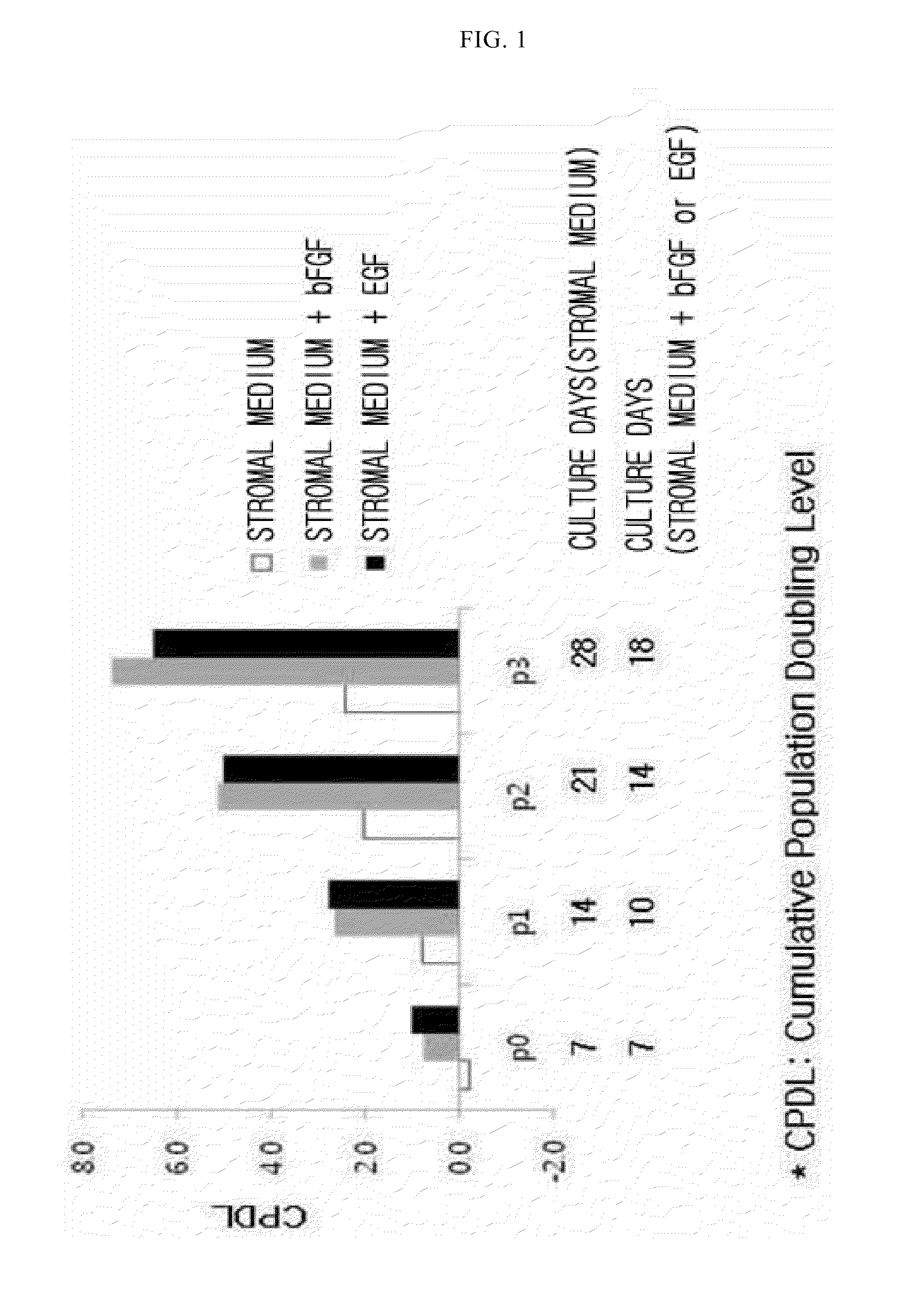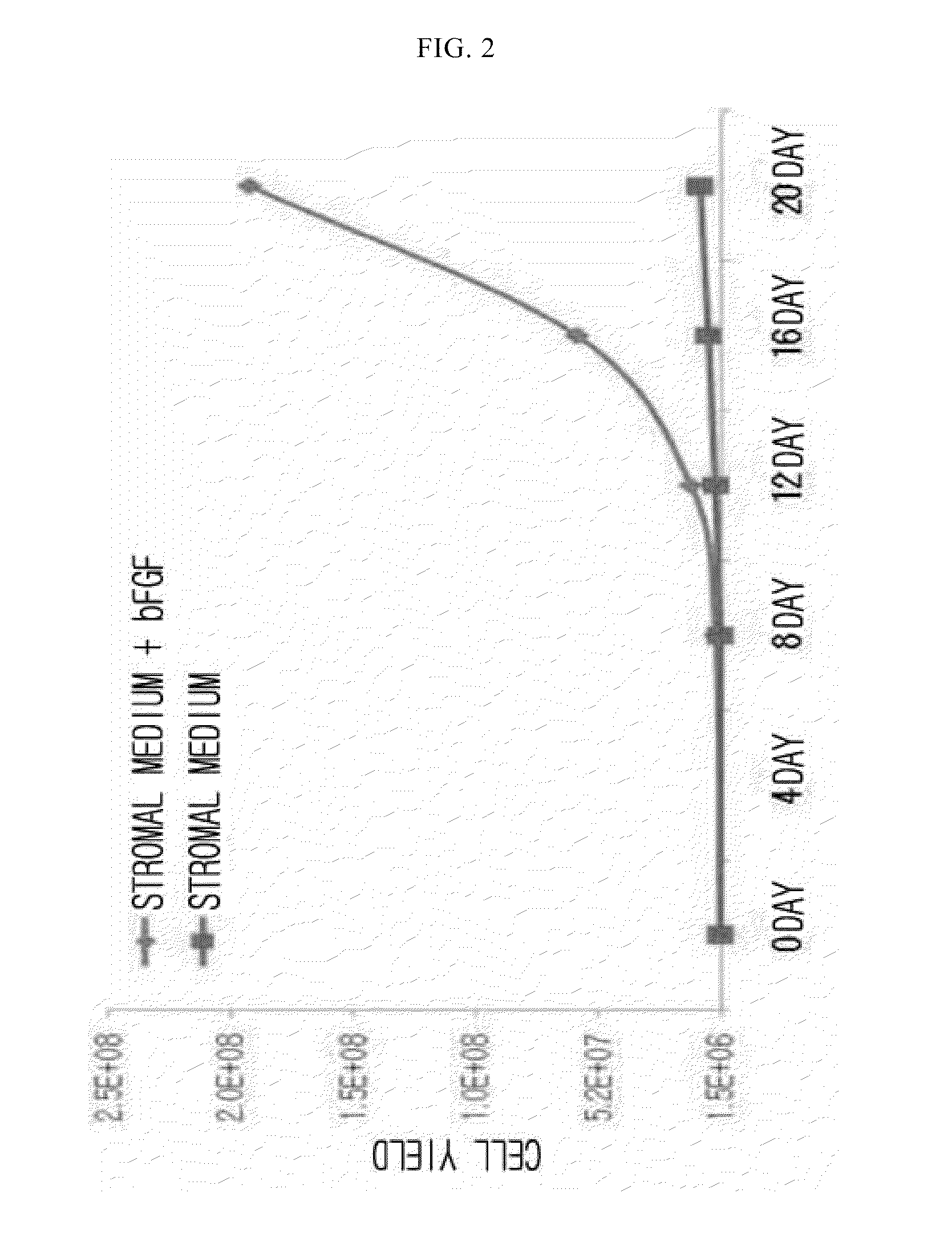Autologous and allogenic adipose-derived stromal stem cell composition for treating fistulas
- Summary
- Abstract
- Description
- Claims
- Application Information
AI Technical Summary
Benefits of technology
Problems solved by technology
Method used
Image
Examples
example 2
Cell Surface Marker of Human Adipose-Derived Stromal Stem Cells
[0074]The dipose-derived stromal cells obtained by the same procedure as described in Example 1 were placed in a 1.5 ml centrifuge tube. After adding 1 ml of a FACS staining solution (a PBS containing 1% fetal bovine serum) thereto and homogeneously mixing the same, centrifugation at 10,000 rpm was conducted for 5 seconds. After removing the supernatant, the remaining product was suspended in 1 ml of FACS staining solution and centrifuged at 10,000 rpm for 5 seconds. After removing the supernatant, the remaining product was re-suspended in 300 μl of the FACS staining solution. The resultant sample was distributed into new centrifuge tubes, such that about 0.5 to 1.0×106 cells are placed in each of the centrifuge tubes, in consideration of the number of samples. After adding an antibody thereto, the content in the tube was subjected to reaction at 4° C. for 30 minutes. Then, the reaction product was re-suspended in 1 ml o...
example 3
Differentiation Ability of Human Adipose-Derived Stromal Stem Cells
[0076]When the adipose-derived stromal stem cells cultured by the same procedure as described in Example 2 were grown to cover 80 to 90% of a culture vessel, the cultured cells were subjected to trypsin treatment to isolate and obtain single cells.
[0077]In order to identify myogenic differentiation ability of the adipose-derived stromal stem cells cultured using each of different media, the cells were inoculated into four (4) wells such that each well contains about 5,000 cells / cm2. The inoculated cells were cultured to fill about 80% of the culture vessel while changing the medium. When the adipose-derived stromal stem cells filled 100% of the culture vessel, the used medium was discarded and replaced with myocyte differentiation medium manufactured by Promocell and differentiation of the stem cells into myocytes was induced for 2 weeks. In order to determine myocyte differentiation rate, immuno-fluorescence stainin...
example 4
Immunomodulatory Activity of Human Adipose-Derived Stromal Stem Cells
[0081]According to an analysis result of human leukocyte antigen (HLA), seven (7) types of human peripheral blood mononuclear cells (PBMC) having various combinations of Type I and II HLAs and adipose-derived stromal stem cells were selected, followed by implementation of mixture lymphocyte reaction (MLR). PBMCs contained in each lot, as responder cells, were added to each well of a U-bottom 96-well plate to be 2×105 cells / well. Then, the adipose-derived stromal stem cells in each lot, as a stimulator, were added in an amount of 2×104 cells to each well. As a positive control, 2×104 PBMCs were treated using mitomycin C and added to the well. On day 3 after reaction, a supernatant was collected and subjected to measurement of an amount of secreted IFN-γ using ELISA method.
[0082]FIG. 5 illustrates immunogenicity of adipose stem cells. As shown in this figure, for PBMCs as the positive control, they reacted with allog...
PUM
 Login to View More
Login to View More Abstract
Description
Claims
Application Information
 Login to View More
Login to View More - R&D
- Intellectual Property
- Life Sciences
- Materials
- Tech Scout
- Unparalleled Data Quality
- Higher Quality Content
- 60% Fewer Hallucinations
Browse by: Latest US Patents, China's latest patents, Technical Efficacy Thesaurus, Application Domain, Technology Topic, Popular Technical Reports.
© 2025 PatSnap. All rights reserved.Legal|Privacy policy|Modern Slavery Act Transparency Statement|Sitemap|About US| Contact US: help@patsnap.com



